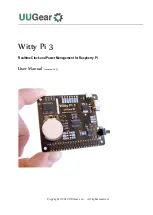
GE Multilin
B30 Bus Differential System
9-5
9 THEORY OF OPERATION
9.3 DIFFERENTIAL PRINCIPLE
9
9.3.2 DIFFERENTIAL AND RESTRAINING CURRENTS
The differential current is produced as a sum of the phasors of the input currents of a differential bus zone taking into
account the status signals of the currents, i.e. applying the dynamic bus replica of the protected zone. The differential cur-
rent is scaled to the maximum rated primary current as explained in Section 8.1 Introduction. The scaling must be taken
into account when setting the
PICKUP
value of the biased differential characteristic and the
HIGH SET
operating point of the
unbiased differential function.
The restraining current is produced as a maximum of the magnitudes of the phasors of the zone input currents taking into
account the status signals of the currents, i.e. applying the dynamic bus replica of the protected bus zone. The restraining
current is scaled to the maximum rated primary current as explained in Section 8.1 Introduction. The scaling must be taken
into account when setting the breakpoints of the biased differential characteristic.
The “maximum of” definition of the restraining signal biases the relay toward dependability without jeopardizing security as
the relay uses additional means to cope with CT saturation on external faults. An additional benefit of this approach is that
the restraining signal always represents a physical – compared to an “average” or “sum of” – current flowing through the CT
that is most likely to saturate during given external fault. This brings more meaning to the breakpoint settings of the operat-
ing characteristic.
The following example is provided with respect to the breakpoint settings.
EXAMPLE 3:
Proceed with the previous example (see page 8–2) and assume that taking into account the relevant factors such as prop-
erties of the CTs themselves, resistance of the leads and burden of the CTs, the following primary currents are guaranteed
to be transformed without significant saturation:
•
1A CT: 6.0 kA
•
1B CT: 7.5 kA
•
1C CT: 5.0 kA
•
1D CT: 13.0 kA
•
1E CT: 8.0 kA
•
1F CT: 9.0 kA
As having the lowest primary current guaranteeing operation without saturation, the CT associated with the 1C input is
most exposed to saturation. During an external fault on the 1C circuit, the 1C CT will carry the fault current contributed by
potentially all the remaining circuits. The fault current is higher than any contributing current, and therefore, the current of
the 1C CT will become the restraining signal for the biased differential characteristic for external faults on the 1C circuit.
Consequently, the higher breakpoint of the differential characteristic (
HIGH BPNT
) should be set not higher than
5000A : 1000A = 5 pu (1000A is the base unit; see page 8–2 for the example).
The same approach applies to the setting of the lower breakpoint,
LOW BPNT
.
Содержание B30 UR Series
Страница 10: ...x B30 Bus Differential System GE Multilin TABLE OF CONTENTS ...
Страница 92: ...3 44 B30 Bus Differential System GE Multilin 3 3 DIRECT INPUT AND OUTPUT COMMUNICATIONS 3 HARDWARE ...
Страница 122: ...4 30 B30 Bus Differential System GE Multilin 4 3 FACEPLATE INTERFACE 4 HUMAN INTERFACES 4 ...
Страница 326: ...5 204 B30 Bus Differential System GE Multilin 5 10 TESTING 5 SETTINGS 5 ...
Страница 412: ...A 12 B30 Bus Differential System GE Multilin A 1 PARAMETER LISTS APPENDIX A A ...
Страница 554: ...D 10 B30 Bus Differential System GE Multilin D 1 IEC 60870 5 104 APPENDIX D D ...
Страница 566: ...E 12 B30 Bus Differential System GE Multilin E 2 DNP POINT LISTS APPENDIX E E ...
Страница 574: ...F 8 B30 Bus Differential System GE Multilin F 3 WARRANTY APPENDIX F F ...
















































